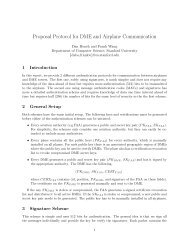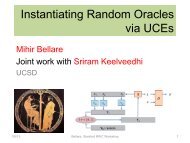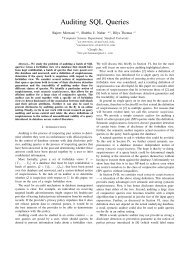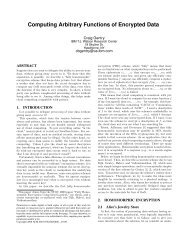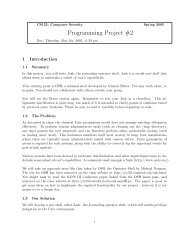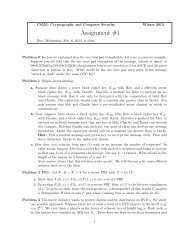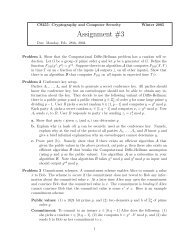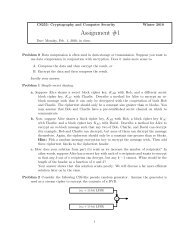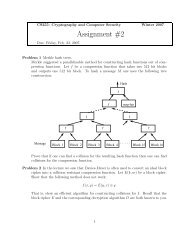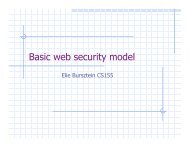You also want an ePaper? Increase the reach of your titles
YUMPU automatically turns print PDFs into web optimized ePapers that Google loves.
<strong>CS155</strong> <strong>Project</strong> 1<br />
Gary Luu<br />
Spring 2009
Setting up the Environment<br />
• Download VMware Player<br />
• http://www.vmware.com/products/player<br />
• If prompted, click “I copied it”<br />
• Should be configured with NAT, check w/ ifconfig<br />
• Demo
int bar(char *arg, char *out)<br />
{<br />
strcpy(out, arg);<br />
return 0;<br />
}<br />
int foo(char *argv[])<br />
{<br />
char buf[128];<br />
bar(argv[1], buf);<br />
}<br />
int main(int argc, char *argv[])<br />
{<br />
if (argc != 2)<br />
{<br />
fprintf(stderr, "target1: argc != 2\n");<br />
exit(EXIT_FAILURE);<br />
}<br />
foo(argv);<br />
return 0;<br />
}<br />
target1.c
Stack During Call to foo<br />
• Target the local buffer “buf” inside of foo<br />
• What’s on the stack after the end of “buf?”<br />
• Stack layout dependent on OS and compiler<br />
• arguments to foo, then return address, then saved<br />
frame pointer, then “buf”<br />
• Explore stack with gdb, read “Smashing the Stack”
sploit1<br />
• Want to overwrite return address of foo()<br />
• Need to insert shellcode in “buf”<br />
• Distance from “buf” and return address on stack<br />
• Remember, this is dependent on compiler/OS<br />
• Make sure your exploits work in VM!
Address of “buf”<br />
• How to obtain?<br />
• Examine stack frame using “info frame”<br />
• Use “x buf” when in foo’s frame<br />
• Stays the same everytime program is invoked<br />
• Address changes when invoked from exec()<br />
• Get address using gdb -e sploit1 -s /tmp/target1
Crafting the Exploit String<br />
• Place shellcode at the start of the string<br />
• Return address ($ra, or saved $eip) exists at<br />
offset 132 on our VM<br />
• 128 bytes of buf, 4 bytes frame pointer<br />
• Write address of “buf” to $ra, 0xbffffd78<br />
• Remember to null terminate your string (strcpy)
Hints<br />
• There are other ways to attack besides<br />
overwriting the return address<br />
• Understand what assembly instructions are doing<br />
• README contains links to Intel x86 assembly<br />
manuals<br />
• Understand what registers $esp, $ebp point to<br />
• What happens when LEAVE and RET called?
IA-32 Review<br />
• x86 is little endian<br />
• $esp: Stack Pointer: points to the top of stack<br />
(which way does the stack grow on x86?)<br />
• $ebp: Frame Pointer: points to fixed location<br />
within an activation record<br />
• Used to reference local vars and parameters since the distance from the frame pointer to these objects stays<br />
constant, while stack pointer changes<br />
• $eip: instruction pointer (aka $ra) ($ebp+4)
•<br />
•<br />
IA-32 Review (cont’d)<br />
When CALL procedure foo()<br />
• Push $eip onto stack, (return address)<br />
• Push $ebp, saving previous frame<br />
• Copy sp into fp, $ebp = $esp<br />
• Decrement $sp for allocations (like buffers)<br />
When LEAVE procedure p()<br />
• Process is reversed<br />
• Load $ebp into $esp<br />
Restore $ebp from stack<br />
•
Interaction Between $esp, $ebp, $eip<br />
• During CALL, value of $eip register pushed onto<br />
stack<br />
• Before RET, programmer should make sure stack<br />
pointer ($esp) is pointing to saved $eip on the<br />
stack<br />
• Move contents of $ebp into $esp<br />
• Increment $esp by 4<br />
• $esp should now point to address of saved $eip<br />
• RET will pop saved $eip into $eip register, processor will execute instruction in<br />
$eip register
Advice<br />
• Start early, you’ll need to read<br />
• “Smashing the Stack” - Aleph 0ne<br />
• “Basic Integer Overflows”<br />
• “Exploiting Format String Vulnerabilities”<br />
• “How to hijack the Global Offset Table...”<br />
• “Once upon a free”<br />
• Reference IA-32 guide (on syllabus with papers)<br />
• Part 2 MUCH harder than Part 1.<br />
• Make a diagram of the stack using gdb
Format Strings<br />
• See Lecture 3 slides pp. 32-37<br />
• Essentially two issues:<br />
• Can arbitrarily read out stuff on stack because<br />
printf() doesn’t check arguments actually<br />
supplied.<br />
• Can write to memory using %n



